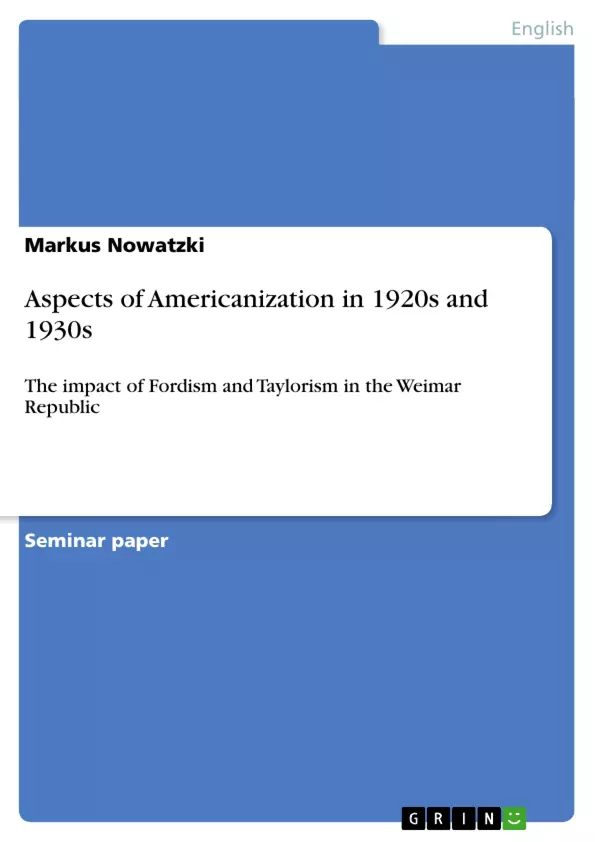Although the Wilhelmian Reich seemed to be relatively stable, political forces and events finally led to the catastrophe of the first World War with its devastating consequences for Europe and especially for Germany, which not only lost part of its territory, but also its political and economical power through the Treaty of Versailles. This state of affairs left an unstable country, in which the public mind increasingly began to look overseas towards an America that showed a solution for most of its economic, social, or political problems. It is true, of course, that Germans had felt the American influence before. However, the peak of this America-boom, whether American friendly or Anti-American, was reached in the Weimar Republic, where a fierce debate on an ambiguous America picture took place.
While European countries mainly stumbled from one bloody conflict to another, America further developed its technology and at the same time its main sociological ideas. Inventors and scientists strived to set up working systems that could make work and life more efficient. Electrification was the charming word of the day, and when Samuel Insull took over Edison′s Commonwealth Edison of Chicago, one of the most powerful and complex systems, both economically and technologically, was set up. This is probably the place where Henry Ford picked up his ideas, and using the Principles of Scientific Management by Frederick Winslow Taylor, he founded another powerful economic system, which soon should become a symbol for modernism all over the world: the Ford Company.
There also was a strong cultural notion in the influence that America had on European countries. Although America and its systems were usually referred to as mass systems, sometimes even as soulless systems without culture and heritage, the Weimar Republic also had been a place of new cultural developments that were taken from American developments and given a European style. This refers especially to the Bauhaus, to the L′Esprit Nouveau, to the movement of the Neue Sachlichkeit, which gained strong publicity through its new style in the public in the1920′s.
Inhaltsverzeichnis (Table of Contents)
- INTRODUCTION
- DEVELOPING SYSTEMS
- A SECOND INDUSTRIAL REVOLUTION
- TAYLOR'S PRINCIPLES OF SCIENTIFIC MANAGEMENT
- SYSTEM BUILDER INSULL
- HENRY FORD AND THE CAR THAT TURNED THE WORLD AROUND
- THE AMERICAN IMPACT ON GERMANY
- GERMANS AND AMERICANIZATION
- CITY LIFE
- JAZZ, MOVIES, AND THE SYMBOLS OF MODERNITY
- LITERARY VOICES IN NEUE SACHLICHKEIT
- BERTOLD BRECHT – AMBIVALENCE IN THE MIND
- THE BAUHAUS SCHOOL - FROM L'ESPRIT NOVEAU OF CORBUSIER TO BAUHAUS OF GROPIUS
- CONCLUSION
Zielsetzung und Themenschwerpunkte (Objectives and Key Themes)
This work explores the influence of American industrial and cultural developments on Germany in the 1920s and 1930s, focusing on the impact of Fordism and Taylorism within the context of the Weimar Republic.
- The rise of American industrial systems, particularly Fordism and Taylorism, and their impact on European society.
- The reception of American culture in Germany during the Weimar Republic, encompassing both positive and negative perspectives.
- The role of technology and its application in shaping modern society, as exemplified by the electrification movement and the development of the automobile.
- The influence of American cultural movements, such as jazz, movies, and the Bauhaus, on European artistic and intellectual trends.
- The complex relationship between Americanization and the cultural and political landscape of the Weimar Republic, highlighting both its potential for progress and its perceived threats.
Zusammenfassung der Kapitel (Chapter Summaries)
- Introduction: The introduction establishes the historical context of the work, exploring the reception of American culture and politics in Germany during the Weimar Republic. It highlights the tumultuous political climate following World War I and the subsequent search for solutions to Germany's economic and social challenges.
- Developing Systems: This chapter delves into the rise of American industrial systems, focusing on the development of the "second industrial revolution." It explores the concepts of scientific management pioneered by Frederick Winslow Taylor, the influence of Samuel Insull in the field of electrification, and the rise of Henry Ford and his automobile empire. The chapter analyzes the social implications of these systems, emphasizing their potential for both progress and controversy.
- The American Impact on Germany: This chapter examines the influence of Americanization on Germany during the Weimar Republic. It explores the varied responses to American culture, including the embrace of American trends like jazz and movies, the influence on German artistic and intellectual movements, and the concerns regarding cultural decline and the perceived homogenization of German society. The chapter also examines the impact of American ideas on German political and social thought, including the adoption of Taylorism by the Bolsheviki and its impact on German labor unions.
Schlüsselwörter (Keywords)
This work explores key concepts such as Americanization, Fordism, Taylorism, the Weimar Republic, Neue Sachlichkeit, the Bauhaus, jazz, movies, and electrification, examining their influence on German society and culture in the 1920s and 1930s.
- Arbeit zitieren
- Markus Nowatzki (Autor:in), 2002, Aspects of Americanization in 1920s and 1930s, München, GRIN Verlag, https://www.grin.com/document/15017



